Different Characteristics of New Particle Formation Events at Two Suburban Sites in Northern China
Abstract
:1. Introduction
2. Site, Measurements and Methods
2.1. Description of the Measurement Site
2.2. Observational Instruments
2.3. Meteorological Conditions
2.4. Classification of New Particle Formation Events
2.5. Condensation Sinks
3. Results and Discussion
3.1. Particle Size Distributions and NPF Events at the Suburb of Xi’an and Beijing
3.2. Characteristics of NPF Events at Two Suburban Sites: Case Study
4. Conclusions
Acknowledgments
Author Contributions
Conflicts of Interest
References
- Sokolik, I.N.; Toon, O.B. Direct radiative forcing by anthropogenic airborne mineral aerosols. Nature 1996, 381, 681–683. [Google Scholar] [CrossRef]
- O’Dowd, C.D. Biogenic coastal aerosol production and its influence on aerosol radiative properties. J. Geophys. Res. 2001, 106, 1545–1549. [Google Scholar] [CrossRef]
- Jung, C.H.; Kim, Y.P. Numerical estimation of the effects of condensation and coagulation on visibility using the moment method. J. Aerosol Sci. 2006, 37, 143–161. [Google Scholar] [CrossRef]
- Samet, J.M.; Dominici, F.; Curriero, F.C.; Coursac, I.; Zeger, S.L. Fine particulate air pollution and mortality in 20 U.S. Cities, 1987–1994. N. Engl. J. Med. 2000, 343, 1742–1749. [Google Scholar] [CrossRef] [PubMed]
- Lippmann, M.; Ito, K.; Nffadas, A.; Burnett, R.T. Association of Particulate Matter Components with Daily Mortality and Morbidity in Urban Populations; Research Report 95; Health Effects Institute: Cambridge, MA, USA, 2000. [Google Scholar]
- Peters, A.; Wichmann, H.E.; Tuch, T.; Heinrich, J.; Heyder, J. Respiratory effects are associated with the number of ultrafine particles. Am. J. Respir. Crit. Care Med. 1997, 155, 1376–1383. [Google Scholar] [CrossRef] [PubMed]
- Penttinen, P.; Timonen, K.L.; Tiittanen, P.; Mirme, A.; Ruuskanen, J.; Pekkanen, J. Number concentration and size of particles in urban air: Effects on spirometric lung function in adult asthmatic subjects. Environ. Health Perspect. 2001, 109, 319–323. [Google Scholar] [CrossRef] [PubMed]
- Clarke, A.D.; Owens, S.R.; Zhou, J. An ultrafine sea-salt flux from breaking waves: Implications for cloud condensation nuclei in the remote marine atmosphere. J. Geophys. Res. 2006, 111, D06202. [Google Scholar] [CrossRef]
- Mordas, G.; Prokopciuk, N.; Byčenkienė, S.; Ulevicius, V. Optical properties of the urban aerosol particles obtained from ground-based measurements and satellite-based modeling studies. Adv. Meteorol. 2015, 2015, 898376. [Google Scholar] [CrossRef]
- O’Dowd, D.; Facchini, M.C.; Cavalli, F.; Ceburnis, D.; Mircea, M.; Decesari, S.; Fuzzi, S.; Yoon, Y.J.; Putaud, J.P. Biogenically-driven organic contribution to marine aerosol. Nature 2004, 431, 676–780. [Google Scholar] [CrossRef] [PubMed]
- Kulmala, M. Atmospheric science: How particles nucleate and grow. Science 2003, 302, 1000–1001. [Google Scholar] [CrossRef] [PubMed]
- Kumar, P.; Robins, A.; Vardoulakis, A.; Quincey, P. Technical challenges in tackling regulatory concerns for urban atmospheric nano particles. Particuology 2011, 9, 566–571. [Google Scholar] [CrossRef] [Green Version]
- Oberdörster, G.; Oberdörster, E.; Oberdörster, J. Nanotoxicology: An emerging discipline evolving from studies of ultrafine particles. Environ. Health Perspect. 2005, 113, 823–839. [Google Scholar] [CrossRef] [PubMed]
- Kulmala, M.; DalMaso, M.; Mäkelä, M.; Pirjola, M.; Väkevä, M.; Aalto, P.P.; Miikkulainen, P.; Hämeri, K.; O’Dowd, C.D. On the formation, growth and composition of nucleation mode particles. Tellus 2001, 53, 479–490. [Google Scholar] [CrossRef]
- Zhang, R.; Khalizov, A.; Wang, L.; Hu, M.; Xu, W. Nucleation and growth of nanoparticles in the atmosphere. Chem. Rev. 2011, 112, 1957–2011. [Google Scholar] [CrossRef] [PubMed]
- Kulmala, M.; Laaksonen, A.; Pirjola, L. Parameterizations for sulfuric acid/water nucleation rates. J. Geophys. Res. 1998, 103, 8301–8307. [Google Scholar] [CrossRef]
- Korhonen, P.; Kulmala, M.; Laaksonen, A.; Viisanen, Y.; McGraw, R.; Seinfeld, J.H. Ternary nucleation of H2SO4, NH3; H2O in the atmosphere. J. Geophys. Res. 1999, 104, 26349–26353. [Google Scholar] [CrossRef]
- Odum, J.R.; Jungkamp, T.P.; Griffin, R.J.; Flagan, R.C.; Seinfeld, J.H. The atmospheric aerosol-forming potential of whole gasoline vapor. Science 1997, 276, 96–99. [Google Scholar] [CrossRef] [PubMed]
- Holmes, N.S. A review of particle formation events and growth in the atmosphere in the various environments and discussion of mechanistic implications. Atmos. Environ. 2007, 41, 2183–2201. [Google Scholar] [CrossRef] [Green Version]
- Seinfeld, J.H.; Pandis, S.N. Atmospheric Chemistry and Physics; John Wiley and Sons, Inc.: New York, NY, USA, 2007. [Google Scholar]
- Kulmala, M.; Vehkamäki, H.; Petäjä, T.; Dal Maso, M.; Lauri, A.; Kerminen, V.M.; Birmili, W.; McMurry, P.H. Formation and growth rates of ultrafine atmospheric particles: A review of observations. J. Aerosol Sci. 2004, 35, 143–176. [Google Scholar] [CrossRef]
- Boy, M.; Kulmala, M.; Ruuskanen, T.M.; Pihlatie, M.; Reissell, A.; Aalto, P.P.; Keronen, P.; Dal Maso, M.; Hellen, H.; Hakola, H.; et al. Sulphuric acid closure and contribution to nucleation mode particle growth. Atmos. Chem. Phys. 2005, 5, 863–878. [Google Scholar] [CrossRef]
- Riipinen, I.; Sihto, S.-L.; Kulmala, M.; Arnold, F.; Dal Maso, M.; Birmili, W.; Saarnio, K.; Teinil¨a, K.; Kerminen, V.-M.; Laaksonen, A.; et al. Connections between atmospheric sulfuric acid and new particle formation during QUEST III–IV campaigns in Heidelberg and Hyytiälä. Atmos. Chem. Phys. 2007, 7, 1899–1914. [Google Scholar] [CrossRef]
- Jung, J.; Miyazaki, Y.; Kawamura, K. Different characteristics of new particle formation between urban and deciduous forest sites in Northern Japan during the summers of 2010–2011. Atmos. Chem. Phys. 2013, 13, 51–68. [Google Scholar] [CrossRef]
- Zhang, K.M.; Wexler, A.S. A hypothesis for growth of fresh atmospheric nuclei. J. Geophys. Res. 2002, 107, 4577. [Google Scholar] [CrossRef]
- Barsanti, K.C.; McMurry, P.H.; Smith, J.N. The potential contribution of organic salts to new particle growth. Atmos. Chem. Phys. 2009, 9, 2949–2957. [Google Scholar] [CrossRef]
- Conte, M.; Donateo, A.; Dinoi, A.; Belosi, F.; Contini, D. Case Study of Particle Number Fluxes and Size Distributions during Nucleation Events in Southeastern Italy in the summer. Atmosphere 2015, 6, 942–959. [Google Scholar] [CrossRef]
- Held, A.; Klemm, O. Direct measurement of turbulent particle exchange with a twin CPC eddy covariance system. Atmos. Environ. 2006, 40, S92–S102. [Google Scholar] [CrossRef]
- Harrison, R.M.; Jones, M.; Collins, G. Measurements of the physical properties of particles in the urban atmosphere. Atmos. Environ. 1999, 33, 309–321. [Google Scholar] [CrossRef]
- Woo, K.S.; Chen, D.R.; Pui, D.; McMurry, P. Measurements of Atlanta aerosol size distributions: Observations of ultrafine particle events. Aerosol Sci. Technol. 2001, 34, 75–87. [Google Scholar] [CrossRef]
- Hussein, T.; Puustinen, A.; Aalto, P.P.; Mäkelä, J.M.; Hämeri, K.; Kulmala, M. Urban aerosol number size distributions. Atmos. Chem. Phys. 2004, 4, 391–411. [Google Scholar] [CrossRef]
- Birmili, W.; Wiedensohler, A.; Heintzenberg, J.; Lehmann, K. Atmospheric particle number size distribution in central Europe: Statistical relations to air mass and meteorology. J. Geophys. Res. 2001, 32, 5–18. [Google Scholar] [CrossRef]
- Wehner, B.; Wiedensohler, A. Long term measurements of submicrometer urban aerosols: Statistical analysis for correlations with meteorological conditions and trace gases. Atmos. Chem. Phys. 2003, 3, 867–879. [Google Scholar] [CrossRef]
- Stanier, C.O.; Khlystov, A.Y.; Pandis, S.N. Ambient aerosol size distributions and number concentrations measured during the Pittsburgh Air Quality Study (PAQS). Atmos. Environ. 2004, 38, 3275–3284. [Google Scholar] [CrossRef]
- Dal Maso, M.; Sogacheva, L.; Aalto, P.P.; Riipinen, I.; Komppula, M.; Tunved, P.; Korhonen, L.; Suur-Uski, V.; Hirsikko, A.; Kurten, T.; et al. Aerosol size distribution measurements at four Nordic field stations: Identification, analysis and trajectory analysis of new particle formation bursts. Tellus 2007, 59, 350–361. [Google Scholar] [CrossRef]
- Laakso, L.; Koponen, I.K.; Mönkkönen, P.; Kulmala, M.; Kerminen, V.-M.; Wehner, B.; Wiedensohler, A.; Wu, Z.J.; Hu, M. Aerosol particles in the developing world: A comparison between New Delhi in India and Beijing in China. Water Air Soil Pollut. 2006, 173, 5–20. [Google Scholar] [CrossRef]
- Kanawade, V.P.; Tripathi, S.N.; Siingh, D.; Gautam, A.S.; Srivastava, A.K.; Kamra, A.K.; Soni, V.K.; Virendra, S. Observations of new particle formation at two distinct Indian subcontinental urban locations. Atmos. Environ. 2014, 96, 370–379. [Google Scholar] [CrossRef]
- Wu, Z.J.; Hu, M.; Lin, P.; Liu, S.; Wehner, B.; Wiedensohler, A. Particle number size distribution in the urban atmosphere of Beijing, China. Atmos. Environ. 2008, 42, 7967–7980. [Google Scholar] [CrossRef]
- Yue, D.L.; Hu, M.; Wu, Z.J.; Wang, Z.B.; Guo, S.; Wehner, B.; Nowak, A.; Achtert, P.; Wiedensohler, A.; Jung, J.S.; et al. Characteristics of aerosol size distributions and new particle formation in the summer in Beijing. J. Geophys. Res. 2009, 114, D00G12. [Google Scholar] [CrossRef]
- Shen, X.J.; Sun, J.Y.; Zhang, Y.M.; Wehner, B.; Nowak, A.; Tuch, T.; Zhang, X.C.; Wang, T.T.; Zhou, H.G.; Zhang, X.L.; et al. First long-term study of particle number size distributions and new particle formation events of regional aerosol in the North China Plain. Atmos. Chem. Phys. 2011, 11, 1565–1580. [Google Scholar] [CrossRef] [Green Version]
- Liu, S.; Hu, M.; Wu, Z.J.; Wehner, B.; Wiedensohler, A.; Cheng, Y.F. Aerosol number size distribution and new particle formation at a rural/coastal site in Pearl River Delta (PRD) of China. Atmos. Environ. 2008, 25, 6275–6283. [Google Scholar] [CrossRef]
- Gong, Y.G.; Hu, M.; Cheng, Y.F.; Su, H.; Yue, D.G.; Liu, F.; Wiedensohler, A.; Wang, Z.B.; Kalesse, H.; Liu, S.; et al. Competition of coagulation sink and source rate: New particle formation in the Pearl River Delta of China. Atmos. Environ. 2010, 44, 3278–3285. [Google Scholar] [CrossRef]
- Xiao, S.; Wang, M.Y.; Yao, L.; Kulmala, M.; Zhou, B.; Yang, X.; Chen, J.; Wang, D.; Fu, Q.; Worsnop, D.; et al. Strong atmospheric new particle formation in winter in urban Shanghai, China. Atmos. Chem. Phys. 2015, 15, 1769–1781. [Google Scholar] [CrossRef]
- Du, J.; Cheng, T.; Zhang, M.; Chen, J.; He, Q.; Wang, X.; Zhang, R.; Tao, J.; Huang, G.; Li, X.; et al. Aerosol size spectra and particle formation events at urban Shanghai in Eastern China. Aerosol Air Qual. Res. 2012, 12, 1362–1372. [Google Scholar] [CrossRef]
- Herrmann, E.; Ding, A.J.; Kerminen, V.M.; Petäjä, T.; Yang, X.Q.; Sun, J.N.; Qi, X.M.; Manninen, H.; Hakala, J.; Nieminen, T.; et al. Aerosols and nucleation in eastern China: First insights from the new SORPES-NJU station. Atmos. Chem. Phys. 2014, 14, 2169–2183. [Google Scholar] [CrossRef]
- Qi, X.M.; Ding, A.J.; Nie, W.; Petäjä, T.; Kerminen, V.; Xie, Y.; Zheng, L.; Manninen, H.; Aalto, P.; Sun, J.; et al. Aerosol size distribution and new particle formation in the western Yangtze River Delta of China: 2 years of measurements at the SORPES station. Atmos. Chem. Phys. 2015, 15, 12445–12464. [Google Scholar] [CrossRef]
- Zhu, B.; Wang, H.L.; Shen, L.J.; Kang, H.Q.; Yu, X.N. Aerosol Spectra and New Particle Formation Observed in Various Seasons in Nanjing. Adv. Atmos. Sci. 2013, 30, 1632–1644. [Google Scholar] [CrossRef]
- Gao, J.; Wang, J.; Cheng, S.H.; Xue, L.K.; Yan, H.Z.; Hou, L.J.; Jiang, Y.Q.; Wang, W.X. Number concentration and size distributions of submicron particles in Jinan urban area: Characteristics in summer and winter. J. Environ. Sci. 2007, 19, 1466–1473. [Google Scholar] [CrossRef]
- Gao, J.; Wang, T.; Zhou, X.H.; Wu, W.S.; Wang, W.X. Measurement of aerosol number size distributions in the Yangtze River delta in China: Formation and growth of particles under polluted conditions. Atmos. Environ. 2009, 43, 829–836. [Google Scholar] [CrossRef]
- Gao, J.; Chai, F.H.; Wang, T.; Wang, W.X. Particle number size distribution and new particle formation (NPF) in Lanzhou, Western China. Particuology 2011, 9, 611–618. [Google Scholar] [CrossRef]
- Peng, Y.; Liu, X.D.; Dai, J.; Wang, Z.; Dong, Z.P.; Dong, Y.; Chen, C.; Li, X.M.; Zhao, N.; Fan, C. Aerosol size distribution and new particle formation events in the suburb of Xi’an, northwest China. Atmos. Environ. 2017, 153, 194–205. [Google Scholar] [CrossRef]
- Sorribas, M.; de la Morena, B.A.; Wehner, B.; López, J.F.; Prats, N.; Mogo, S.; Wiedensohler, A.; Cachorro, V.E. On the sub-micron aerosol size distribution in a coastal-rural site at El Arenosillo Station (SW–pain). Atmos. Chem. Phys. 2011, 11, 11185–11206. [Google Scholar] [CrossRef] [Green Version]
- Dal Maso, M.; Kulmala, M.; Riipinen, I.; Wagner, R.; Hussein, T.; Aalto, P.; Lehtinen, E.J. Formation and growth rates of fresh atmospheric aerosols: Eight years of aerosol size distribution data from SMEARII, Hyytiälä, Finland. Boreal Environ. Res. 2005, 10, 323–336. [Google Scholar]
- Park, K.; Park, J.Y.; Kwak, J.H.; Cho, G.N.; Kim, J.S. Seasonal and diurnal variations of ultrafine particle concentration in urban Gwangju, Korea: Observation of ultrafine particle events. Atmos. Environ. 2008, 42, 788–799. [Google Scholar] [CrossRef]
- Watson, J.G.; Chow, J.C.; Park, K.; Lowenthal, D.H. Nanoparticle and ultrafine particle events at the Fresno supersite. J. Air Waste Manag. Assoc. 2006, 56, 417–430. [Google Scholar] [CrossRef] [PubMed]
- Fuchs, N.A.; Sutugin, A.G. Highly Dispersed Aerosol. In Topics in Current Aerosol Research; Hidy, G.M., Brock, J.R., Eds.; Pergamon: New York, NY, USA, 1971. [Google Scholar]
- Wu, Z.J.; Hu, M.; Liu, S.; Wehner, B.; Bauer, S.; Ma ßling, A.; Wiedensohler, A.; Petäjä, T.; Dal Maso, M.; Kulmala, M. New particle formation in Beijing, China: Statistical analysis of a 1-year data set. J. Geophys. Res. 2007, 112, D09209. [Google Scholar] [CrossRef]
- Cheung, H.C.; Morawska, L.; Ristovski, Z.D. Observation of new particle formation in subtropical urban Environment. Atmos. Chem. Phys. 2011, 11, 3823–3833. [Google Scholar] [CrossRef] [Green Version]
- Yue, D.L.; Hu, M.; Wang, Z.B.; Wen, M.T.; Guo, S.; Zhong, L.J.; Wiedensohler, A.; Zhang, Y.H. Comparison of particle number size distributions and new particle formation between the urban and rural sites in the PRD region, China. Atmos. Environ. 2013, 76, 181–188. [Google Scholar] [CrossRef]
- Mönkkönen, P.; Koponen, I.K.; Lehtinen, K.E.J.; Hämeri, K.; Uma, R.; Kulmala, M. Measurements in a highly polluted Asian mega city: Observations of aerosol number size distribution, modal parameters and nucleation events. Atmos. Chem. Phys. 2005, 5, 57–66. [Google Scholar] [CrossRef]
- Draxler, R.R.; Rolph, G.D. HYSPLIT (HYbrid Single-Particle Lagrangian Integrated Trajectory) Model Access via Noaa ARL READY Website (http://ready.arl.noaa.gov/HYSPLIT.php); NOAA Air Resources Laboratory: Silver Spring, MD, USA, 2012.
- Kulmala, M.; Petäjä, T.; Nieminen, T.; Sipilä, M.; Manninen, H.E.; Lehtipalo, K.; Dal Maso, M.; Aalto, P.P.; Junninen, H.; Paasonen, P.; et al. Measurement of the nucleation of atmospheric aerosol particles. Nat. Protoc. 2012, 7, 1651–1667. [Google Scholar] [CrossRef] [PubMed]
- Birmili, W.; Wiedensohler, A. New particle formation in the continental boundary layer: Meteorological and gas phase parameter influence. Geophys. Res. Lett. 2000, 27, 3325–3328. [Google Scholar] [CrossRef]
- Hyvönen, S.; Junninen, H.; Laakso, L.; Dal Maso, M.; Grönholm, T.; Bonn, B.; Keronen, P.; Aalto, P.; Hiltunen, V.; Pohja, T.; et al. A look at aeionrosol format using data mining techniques. Atmos. Chem. Phys. 2005, 5, 3345–3356. [Google Scholar] [CrossRef]
- Hamed, A.; Joutsensaari, J.; Mikkonen, S.; Sogacheva, L.; Dal Maso, M.; Kulmala, M.; Cavalli, F.; Fuzzi, S.; Facchini, M.C.; Decesari, S.; et al. Nucleation and growth of new particles in Po Valley, Italy. Atmos. Chem. Phys. 2007, 7, 355–376. [Google Scholar] [CrossRef]
- Hamed, A.; Korhonen, H.; Sihto, S.L.; Joutsensaari, J.; Jarvinen, H.; Petaja, T.; Arnold, F.; Nieminen, T.; Kulmala, M.; Smith, J.N.; et al. The role of relative humidity in continental new particle formation. J. Geophys. Res. 2011, 116, D03202. [Google Scholar] [CrossRef]
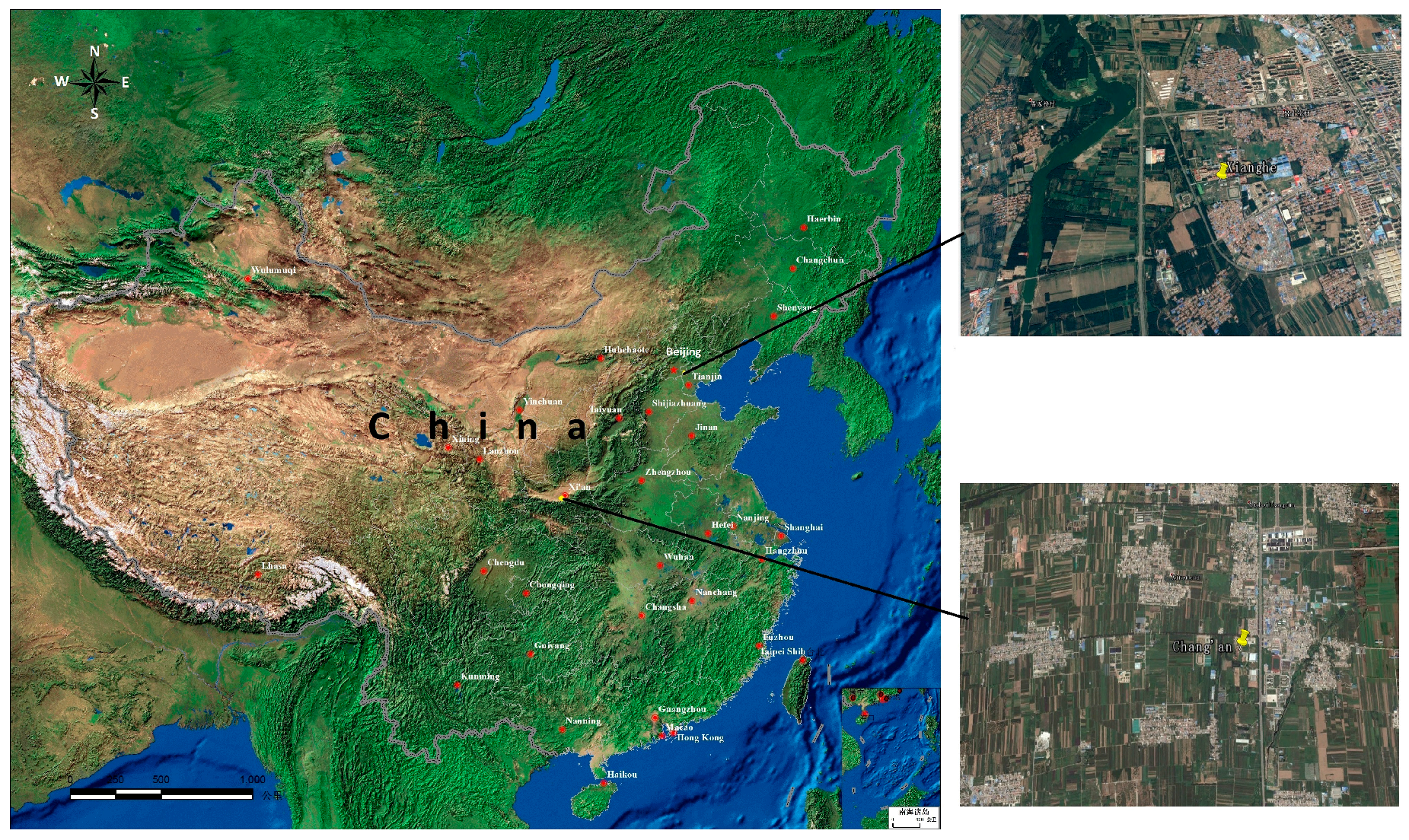

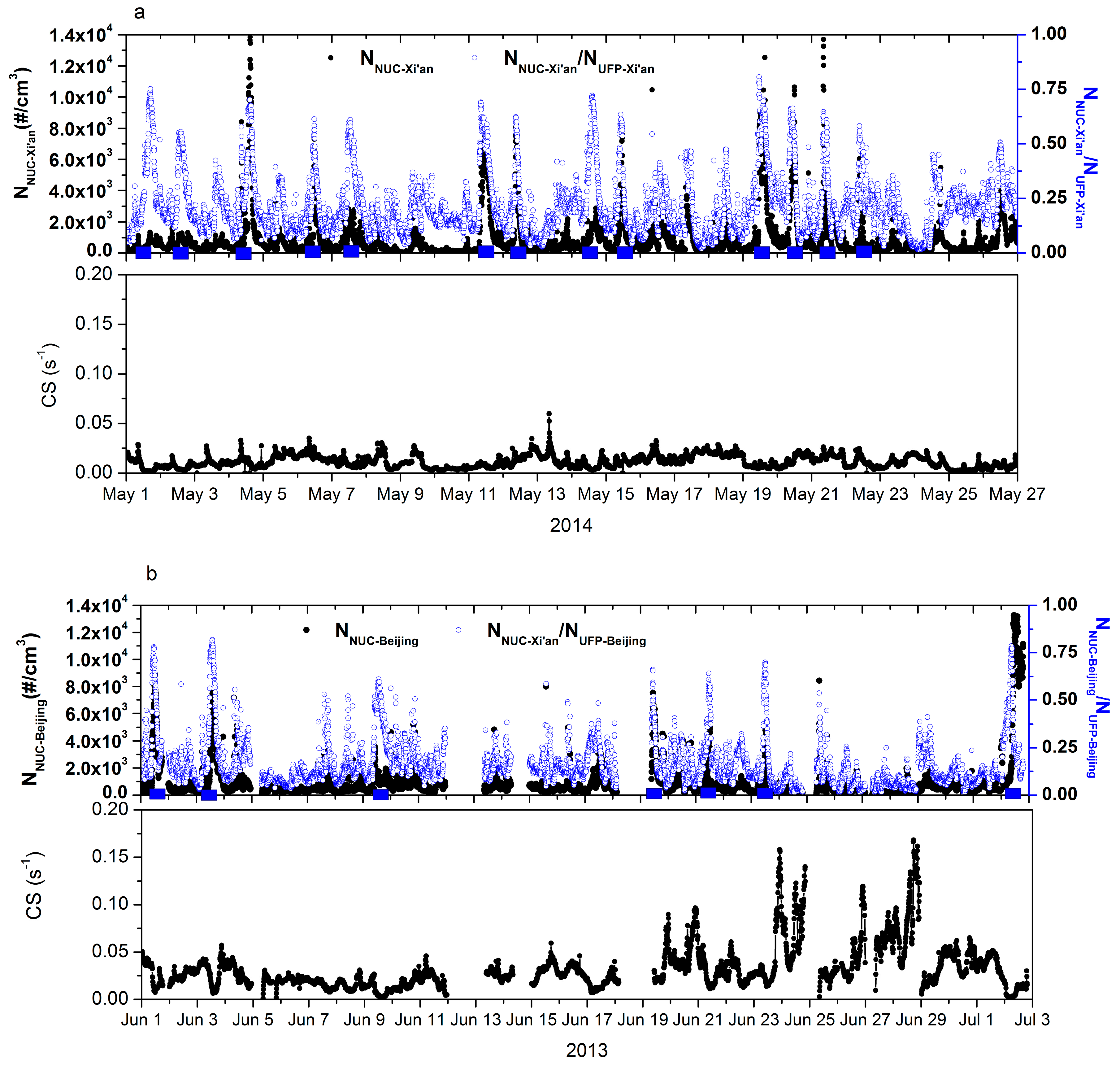
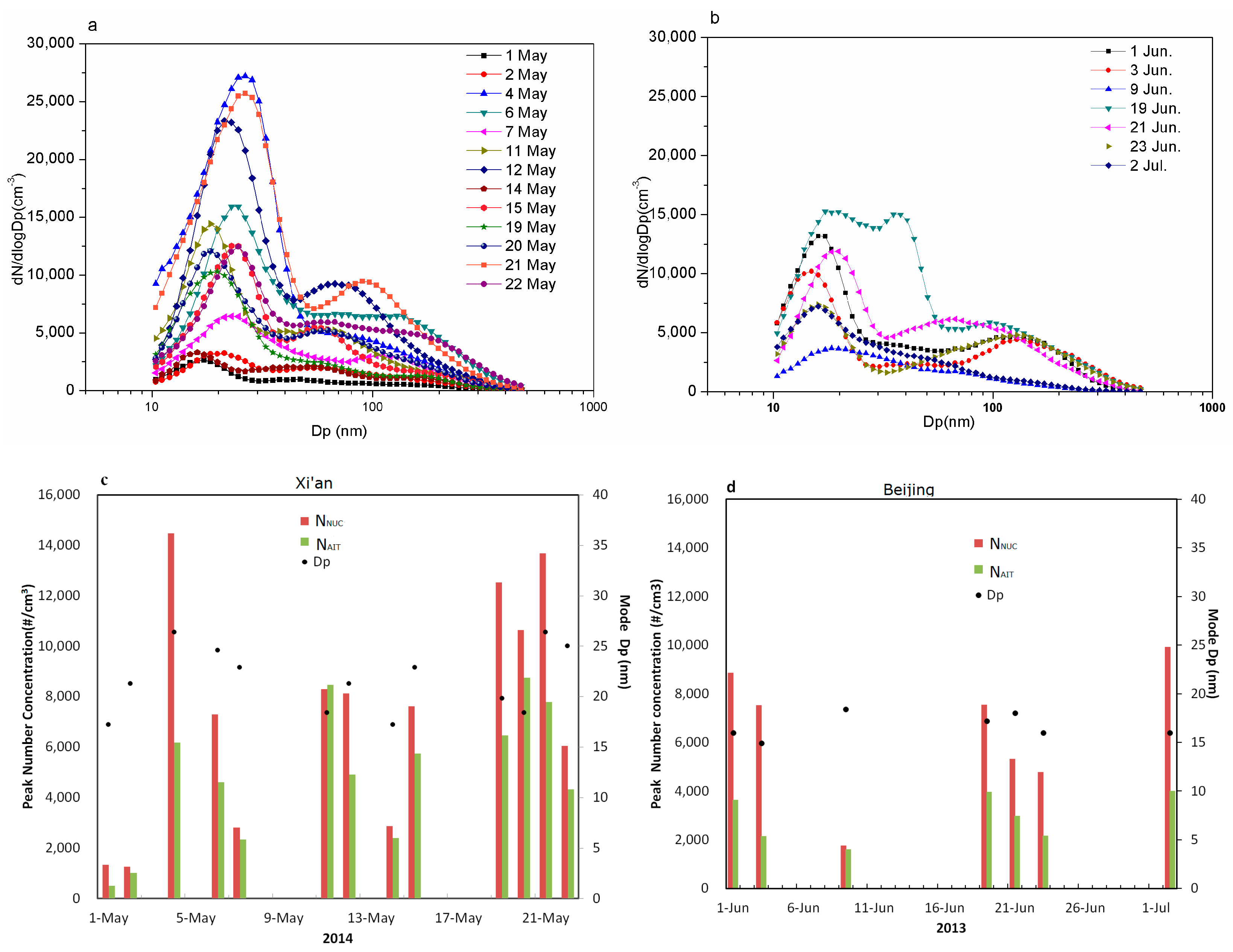
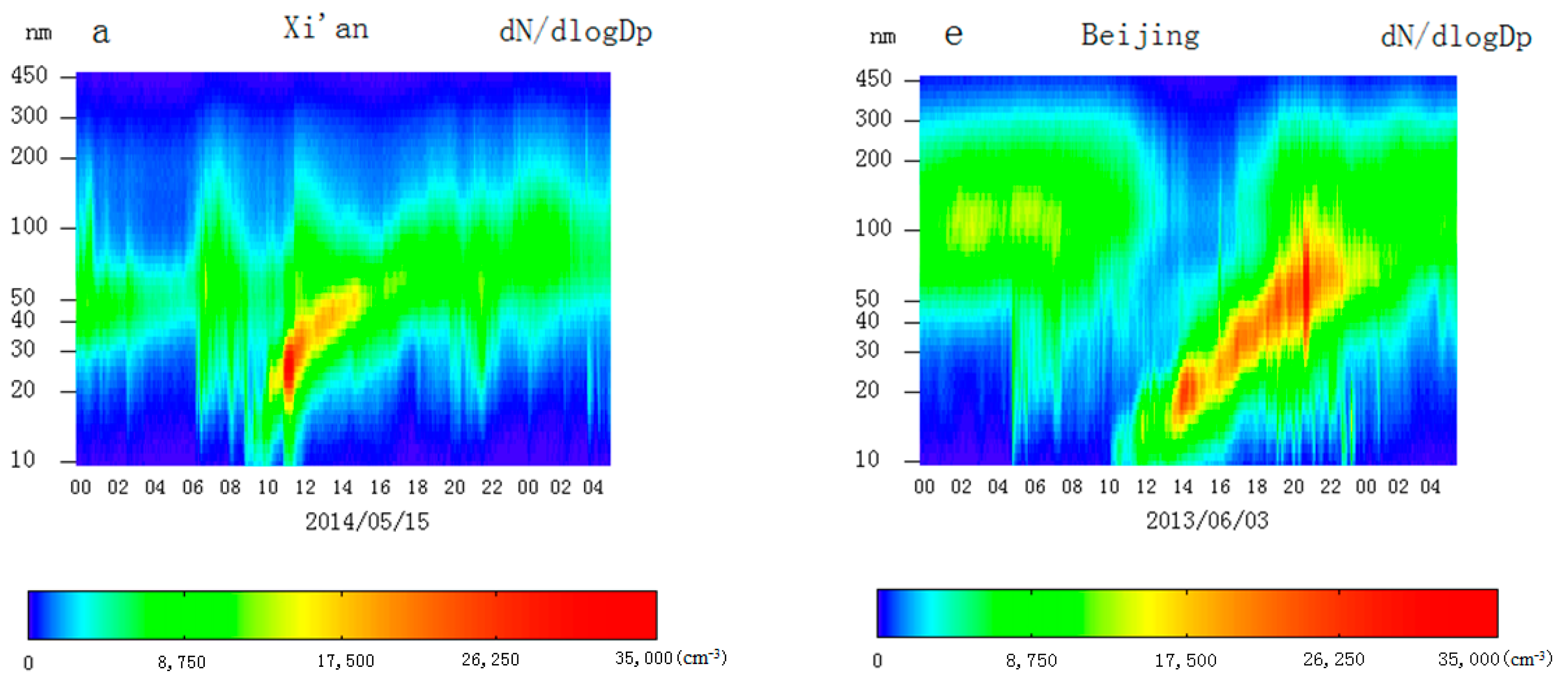

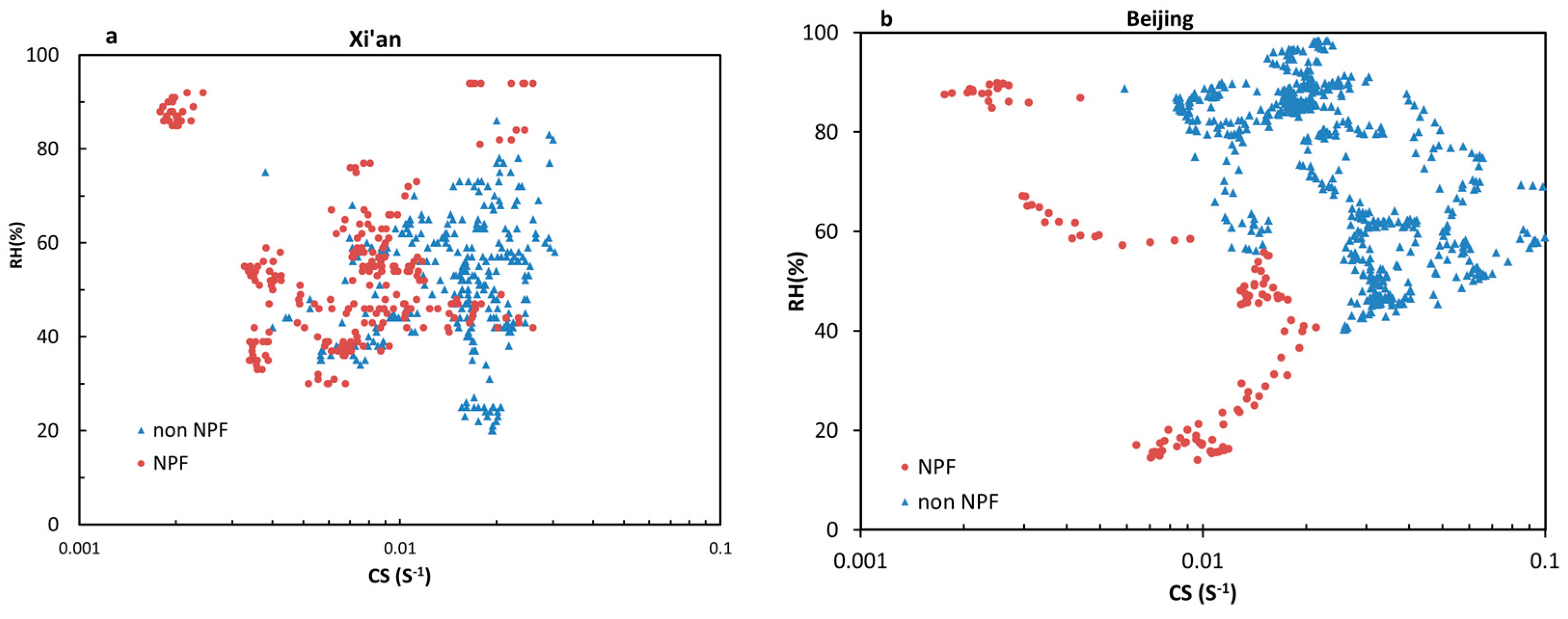
| Parameter | Xi’an | Beijing | ||||||
|---|---|---|---|---|---|---|---|---|
| AVG ± S.D. | Median | Min | Max | AVG ± S.D. | Median | Min | Max | |
| NNUC (cm−3) | 872 ± 1324 | 447 | 24 | 10,582 | 855 ± 988 | 557 | 3 | 8496 |
| NAIT (cm−3) | 2501 ± 1560 | 2193 | 338 | 10,626 | 4265 ± 2261 | 3705 | 82 | 12,611 |
| NACC (cm−3) | 1314 ± 783 | 1162 | 201 | 5117 | 3923 ± 3140 | 3155 | 51 | 19,855 |
| NUFP (cm−3) | 3373 ± 2525 | 2748 | 363 | 16,320 | 5120 ± 2673 | 4349 | 85 | 16,735 |
| CS (s−1) | 0.0113 ± 0.006 | 0.0102 | 0.0019 | 0.0418 | 0.0311 ± 0.023 | 0.0255 | 0.0011 | 0.150 |
| Mode Dp (nm) | 67 ± 29 | 64 | 17 | 176 | 89 ± 30 | 91 | 15 | 189 |
| Data | Nucleation (Starting–Ending Time) | Mode Dp (nm) | Growth Rate (nm/h) | Peak Particle Number Concentration * (cm−3) | CS (s−1) ** | |
|---|---|---|---|---|---|---|
| NNUC | NAIT | |||||
| 1 May 2014 | 15:25–19:25 LST | 17 | N/A | 1339 | 507 | 0.0020 |
| 2 May 2014 | 12:30–15:30 LST | 21 | 3.9 | 1268 | 1014 | 0.0038 |
| 4 May 2014 | 13:25–16:25 LST | 26 | 3.3 | 14,478 | 6172 | 0.0122 |
| 6 May 2014 | 11:25–12:05 LST | 25 | 6.7 | 7291 | 4609 | 0.0217 |
| 7 May 2014 | 11:05–14:10 LST | 23 | 3.3 | 2822 | 2348 | 0.0074 |
| 11 May 2014 | 07:25–13:20 LST | 18 | 3.3 | 8291 | 8460 | 0.0080 |
| 12 May 2014 | 08:30–10:00 LST | 21 | 5.5 | 8117 | 4917 | 0.0163 |
| 14 May 2014 | 12:20–17:10 LST | 17 | 3.3 | 2872 | 2402 | 0.0039 |
| 15 May 2014 | 09:30–12:30 LST | 23 | 6.1 | 7608 | 5751 | 0.0087 |
| 19 May 2014 | 10:55–16:15 LST | 20 | N/A | 12,525 | 6458 | 0.0069 |
| 20 May 2014 | 08:30–12:05 LST | 18 | 5.8 | 10,640 | 8751 | 0.0107 |
| 21 May 2014 | 07:15–08:45 LST | 26 | N/A | 13,690 | 7779 | 0.0198 |
| 22 May 2014 | 09:15–10:00 LST | 25 | 5.1 | 6036 | 4331 | 0.0216 |
| Max | 28 | 6.7 | 14,478 | 8751 | 0.0260 | |
| Min | 17 | 3.3 | 1268 | 507 | 0.0033 | |
| AVG | 22 | 4.8 | 7235 | 6069 | 0.0093 | |
| S.D. | 4 | 1.4 | 4430 | 5249 | 0.0054 | |
| Data | Nucleation (Starting–Ending Time) | Mode Dp (nm) | Growth Rate (nm/h) | Peak Particle Number Concentration (cm−3) | CS (s−1) | |
|---|---|---|---|---|---|---|
| NNUC-Beijing | NAIT-Beijing | |||||
| 1 June 2013 | 09:50–13:15 LST | 16 | 6.0 | 8857 | 3645 | 0.0113 |
| 3 June 2013 | 11:35–16:30 LST | 15 | 4.6 | 7526 | 2151 | 0.0103 |
| 9 June 2013 | 12:50–15:55 LST | 18 | N/A | 1770 | 1608 | 0.0025 |
| 19 June 2013 | 10:25–11:10 LST | 17 | N/A | 7543 | 3975 | 0.0191 |
| 21 June 2013 | 10:50–12:30 LST. | 18 | N/A | 5325 | 2983 | 0.0138 |
| 23 June 2013 | 10:45–13:05 LST | 16 | 7.3 | 4787 | 2173 | 0.0153 |
| 2 July 2013 | 07:30–10:10 LST | 16 | 8.6 | 9927 | 4016 | 0.0047 |
| Max | 18 | 8.6 | 9927 | 4016 | 0.0214 | |
| Min | 15 | 4.6 | 1770 | 1608 | 0.0018 | |
| AVG | 17 | 6.6 | 6534 | 2935 | 0.0091 | |
| S.D. | 1 | 1.5 | 2567 | 903 | 0.0053 | |
© 2017 by the authors. Licensee MDPI, Basel, Switzerland. This article is an open access article distributed under the terms and conditions of the Creative Commons Attribution (CC BY) license (http://creativecommons.org/licenses/by/4.0/).
Share and Cite
Peng, Y.; Dong, Y.; Li, X.; Liu, X.; Dai, J.; Chen, C.; Dong, Z.; Du, C.; Wang, Z. Different Characteristics of New Particle Formation Events at Two Suburban Sites in Northern China. Atmosphere 2017, 8, 258. https://doi.org/10.3390/atmos8120258
Peng Y, Dong Y, Li X, Liu X, Dai J, Chen C, Dong Z, Du C, Wang Z. Different Characteristics of New Particle Formation Events at Two Suburban Sites in Northern China. Atmosphere. 2017; 8(12):258. https://doi.org/10.3390/atmos8120258
Chicago/Turabian StylePeng, Yan, Yan Dong, Xingmin Li, Xiaodong Liu, Jin Dai, Chuang Chen, Zipeng Dong, Chuanli Du, and Zhaosheng Wang. 2017. "Different Characteristics of New Particle Formation Events at Two Suburban Sites in Northern China" Atmosphere 8, no. 12: 258. https://doi.org/10.3390/atmos8120258





